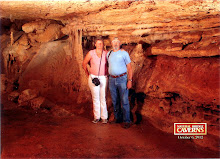
Saguaro National Park East, the Rincon Mountain District, is on the east side of Tucson. This district ranges in elevation from 2670 ft. to 8666 ft. The lower elevations encompass the Sonoran Desert Vegetation, but the higher areas may be comprised of mixed conifer forests to include pine and fir. In this district you can find more than 1162 species of plants.
Don't ask Bear about Teddy bear cholla, He is not interested in meeting any more of them. It took a pair of pliers to clean him up from his first encounter with one.
That's not a dead plant in the foreground its a Staghorn cholla. Also looking dead behind it and to the left is an ocotilla, both are very much alive and waiting for rain.

This little guy, the Javelina, looks like a pig but is not. Although closely related and is in the same Family. They run wild all over the area, not only in rural country but in urban Tucson as well.
The ones we have seen on the ranch are very shy and very hard to photo up close. We will keep trying. These short legged little critters can move really fast when startled.

At the top of this Prickly Pear Cactus sits a Cactus Wren. Seems to be a common bird here in Arizona.
They are also very mischievous. We need to be care full about what we display as they will try to eat anything, even frozen dog bones.

This misguided wren thought he would try some of Bears dog food, a nearly fatal mistake. Fortunately wrens are faster than Great Danes. Bear is not willing to share.
One of more than twenty Spanish missions established By father Kino and other Jesuits, and later expanded upon by Franciscan missionaries.
Mission San Jose de Tumacacori was established in January 1691.

In 1691 Tubac was a small Pima Indian village. Spanish colonists started to colonize the area in the 1730s. The Presidio San Ignacio de Tubac was established in 1752 to protect the town and surrounding area from the Indians. Tubac became the first European settlement in what today is the state of Arizona.

Canelo Pass is the North Eastern exit from the San Rafael Valley over the Canelo Hills.

In 1691 Tubac was a small Pima Indian village. Spanish colonists started to colonize the area in the 1730s. The Presidio San Ignacio de Tubac was established in 1752 to protect the town and surrounding area from the Indians. Tubac became the first European settlement in what today is the state of Arizona.

Canelo Pass is the North Eastern exit from the San Rafael Valley over the Canelo Hills.

The San Rafael Valley from Canelo Pass. Home of the San Rafael State Natural Area. Currently not open to the public. The Natural Area preserves a native grassland area that has not suffered problems of shrubs and cactus invasion, nor has been taken over by exotic plant species that affect so much of this vegetation type elsewhere in Arizona and the southwest.

The bridge over the inlet to the marina at Patagonia Lake State Park.
Yep, the bridge.

White Tail Deer, seen on the way to Parker Canyon Lake. There were two of them, but before I could get the other in the view finder they were both gone.

Parker Canyon Lake from the trail head of the Arizona Trail.

Parker Canyon Lake is directly East of the Ranch outside the Valley. Many of the same animals found in the Valley are also found around the lake. One can see Mule Deer, Javalina, Antelope (Pronghorn), Bobcats, Cougar, and Coyote. The only one we have not seen is the Cougar.
Some interesting looking clouds over Patagonia.

The camera did not capture the blue around the brighter gray area of this cloud. It was really quite spectacular.
Oh yes there was the question how many species of Prickly Pear Cactus are there. Currently, only prickly pears are included in the genus Opuntia, a genus of about 200 species distributed throughout most of the Americas. Apparently Chollas, such as the Teddy Bear Chollas, have been kicked out of the prickly pear club, Bear is good with that.















No comments:
Post a Comment